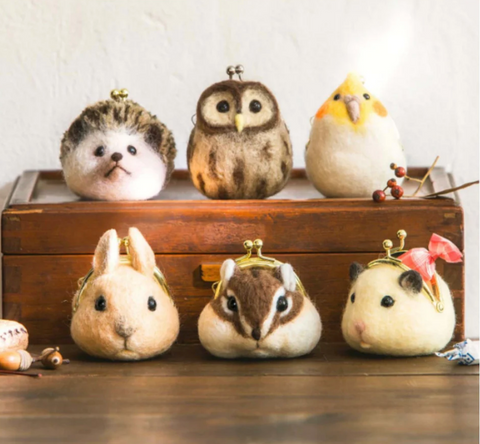
No, you cannot use a regular sewing needle for needle felting. Needle felting requires special barbed needles that are designed specifically for the task. These needles have barbs or notches along the shaft that catch and tangle the fibers of the wool as you repeatedly poke the needle into the wool. This process causes the fibers to interlock and compact, creating a dense, firm shape.
Regular sewing needles do not have barbs, so they cannot effectively tangle and interlock the wool fibers. If you attempt to use a regular sewing needle for needle felting, you will likely find that it takes much longer to achieve the desired result, and your finished product may not be as firm or sturdy as it would be if you used a barbed needle.
So, if you are interested in needle felting, it's important to invest in a set of barbed needles designed specifically for the craft. These needles are readily available at craft stores and online retailers.

electric needle felting machine
No, you cannot use a regular sewing needle for needle felting. Needle felting requires special barbed needles that are designed specifically for the task. These needles have barbs or notches along the shaft that catch and tangle the fibers of the wool as you repeatedly poke the needle into the wool. This process causes the fibers to interlock and compact, creating a dense, firm shape.
Regular sewing needles do not have barbs, so they cannot effectively tangle and interlock the wool fibers. If you attempt to use a regular sewing needle for needle felting, you will likely find that it takes much longer to achieve the desired result, and your finished product may not be as firm or sturdy as it would be if you used a barbed needle.

needle felting kit for beginners with tutorials
So, if you are interested in needle felting, it's important to invest in a set of barbed needles designed specifically for the craft. These needles are readily available at craft stores and online retailers.
here's some additional information about using a sewing needle for needle felting:
As mentioned earlier, regular sewing needles do not have the barbs or notches along the shaft that are necessary for effective needle felting. The barbs on a needle felting needle catch and interlock the wool fibers, allowing them to be compacted and sculpted into the desired shape.
In addition to the barbs, needle felting needles also come in different gauges or thicknesses. The finer the gauge, the finer the details that can be achieved in the finished product. Coarser needles are better suited for larger projects or for quickly shaping the wool.
It's important to note that needle felting needles are quite sharp and should be handled with care. It's also a good idea to use a foam pad or mat to protect your work surface and prevent the needle from breaking.
When needle felting, the wool fibers should be compacted gradually and evenly, with the needle being repeatedly inserted into the wool and then removed. The direction of the needle should also be varied, as this will affect the direction of the wool fibers and the overall texture of the finished piece.

new needle felting animals kit with lights to decor room
Overall, using a barbed needle specifically designed for needle felting is the best way to achieve the desired results and create a sturdy, well-formed finished product.
Needle felting is a craft that involves using a special barbed needle to manipulate wool fibers into a desired shape or design. It can be used to create a variety of objects, such as animals, flowers, or even clothing and accessories.
The process of needle felting involves repeatedly poking the wool with the barbed needle, causing the fibers to tangle and interlock with each other. This creates a dense, solid shape that can be molded and sculpted into different forms. The technique is often used in combination with wet felting, which involves using water and soap to fuse the wool fibers together.
Needle felting needles come in different gauges or thicknesses, with finer needles used for intricate details and coarser needles used for larger projects or for shaping the wool more quickly.
Barbed needles for needle felting come in different sizes or gauges, with the gauge referring to the thickness of the needle. Thinner needles with a higher gauge number are best for adding finer details to your project, while thicker needles with a lower gauge number are better for shaping and compacting larger areas of wool.
When using a barbed needle for needle felting, it's important to take safety precautions since these needles are very sharp. Always hold the needle by the base or handle, and avoid touching the needle tip. It's also a good idea to use a foam pad or felting mat to prevent the needle from breaking and to protect your work surface.
To needle felt, place a small amount of wool roving or fiber onto your felting surface, and repeatedly poke the needle into the wool while varying the direction of your needle strokes. This action tangles and compresses the wool fibers together, gradually shaping and compacting the wool into the desired shape.
When working with a barbed needle, keep in mind that the barbs catch and tangle the fibers, so it's important to be gentle and work slowly, especially when working on finer details. Always be mindful of the direction you're poking the needle in, as this affects the overall texture of the wool.
With practice, you'll be able to use a barbed needle to create a wide variety of needle felted items, from small details to larger sculptures. Needle felting can be a fun and rewarding craft, and using the right tools, such as a barbed needle, is key to achieving great results.

